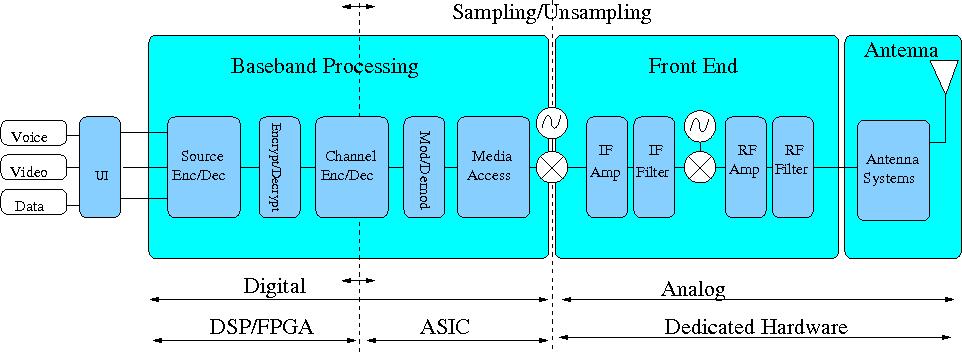Section: Overall Objectives
Technological State of the Art
A Software-Defined Radio (sdr ) system is a radio communication system in which computations that in the past were typically implemented in hardware (e.g. mixers, filters, amplifiers, modulators/demodulators, detectors, etc.) are instead implemented as software programs [33], [29].
SDR Technology
|
The different components of a radio system are illustrated in Fig. 2. Of course, all of the digital components may not be programmable, but the bigger the programmable part (dsp /fpga part on Fig. 2), the more software the radio. Dedicated ip s. In this context, ip stand for Intellectual Properties, this term is widely used to designated dedicated special-purpose circuit blocks implemented in various technologies: Asic, fpga , dsp , etc. are needed, for these ip it is more suitable to use the term configurable than programmable. In a typical sdr , the analog part is limited to a frequency translation down to an intermediate band which is sampled and all the signal processing is done digitally.
SDR Forum Classification
To encourage a common meaning for the term “sdr ” the sdr Forum (recently renamed Wireless Innovation Forum (http://www.wirelessinnovation.org) proposes to distinguish five tiers:
-
Tier 0 – Hardware Radio: The radio parameters cannot be changed, radio is implemented only with hardware components.
-
Tier 1 – Software Controlled Radio: A radio where only the control functions are implemented in software, baseband processing is still performed in hardware, the radio is able to switch between different hardware.
-
Tier 2 – Software-Defined Radio: The most popularly understood definition of sdr : the radio includes software control of modulation, bandwidth, frequency range and frequency bands. Conversion to digital domain still occurs after frequency conversion. It is currently implemented using a wide range of technologies: Asics, fpga s, dsp s, etc.
-
Tier 3 – Ideal Software Radio: Digital conversion occurs directly at the antenna, programmability extends to the whole system.
-
Tier 4 – Ultimate Software Radio: Same reconfigurability capabilities as in Tier 3, but with a switching between two configurations in less than one millisecond.
The main restriction to build an ideal software radio is sampling rate: sampling at a high rate is not an easy task. Following the Shannon-Nyquist theorem, sampling the rf signal at a rate greater than twice the frequency of the signal is sufficient to reconstruct the signal. Sampling can be done at lower rate (decimation), but errors can be introduced (aliasing) that can be corrected by filtering (dirty radio concept). Building an sdr terminal implies a trade-of between sampling frequency and terminal complexity. For instance, sampling at 4.9 GHz would require a 12-bit resolution adc with at least 10GHz sample rate which is today not available with reasonable power consumption (several hundreds Watt).
Cognitive Radio
sdr technology enables over the air programming (Otap) which consists in describing methods for distributing new software updates through the radio interface. However, as sdr architectures are heterogeneous, a standard distribution method has not emerged yet.
Cognitive Radio is a wireless communication system that can sense the air, and decide to configure itself in a given mode, following a local or distributed decision algorithm. Although Tier 3 sdr would be an ideal platform for cognitive radio implementation, cognitive radios do not have to be sdr .
Cognitive Radio is currently a very hot research topic as show the dozens of sessions in research conferences dedicated to it. In 2009, the American National Science Foundation (nsf ) held a workshop on “Future Directions in Cognitive Radio Network Research” [35]. The purpose of the workshop was to explore how the transition from cognitive radios to cognitive radio networks can be made. The resulting report indicated the following:
Emerging cognitive radio technology has been identified as a high impact disruptive technology innovation, that could provide solutions to the radio traffic jam problem and provide a path to scaling wireless systems for the next 25 years.
Significant new research is required to address the many technical challenges of cognitive radio networking. These include dynamic spectrum allocation methods, spectrum sensing, cooperative communications, incentive mechanisms, cognitive network architecture and protocol design, cognitive network security, cognitive system adaptation algorithms and emergent system behavior.
The report also mentioned the lack of cognitive radio testbeds and urged “The development of a set of cognitive networking test-beds that can be used to evaluate cognitive networks at various stages of their development”, which, in some sense strengthens the creation of the Socrate team and its implication in the FIT project [30].


